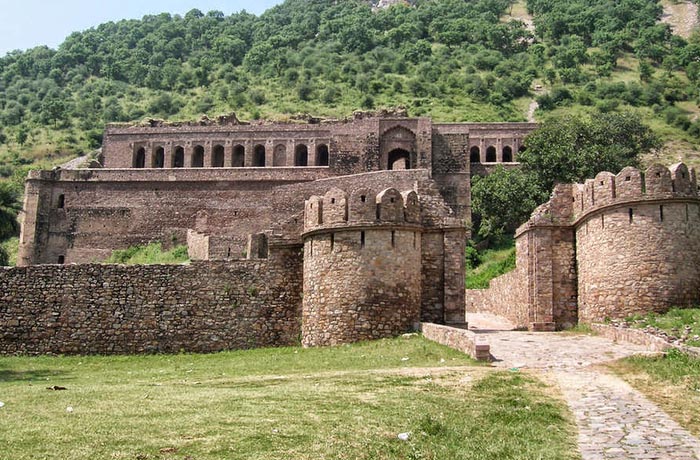Bandhavgarh Fort

Information on Bandhavgarh Fort (Umaria, Madhya Pradesh) - History & Architecture
The fort of Bandhavgarh can be stated as one of the prehistoric and religious places of India. It can be sited in the Bandhavgarh region of the Umaria district of Madhya Pradesh. The fort is located at the highest peak of the Vindhyachal mountain range at an elevation of about 811 metres above the normal ground level. Though, at present in its ruins, the fort is surrounded by small hills around it. Situated at the centre of the Bandhavgarh National Park, the fort represents an attractive view of the park and it also houses some of the extinct spices of vultures in India.
Bandhavgarh Fort Architecture
The architectural significance of the Fort of Bandhavgarh is as impressive as its historical significance was. The fort is highly religious so many sculptures and statues relating to the Hindu gods can be witnessed here. The many forms and avatars of Lord Vishnu in the form of sculptures can be spotted here. Matsya, Narashima, Varaha and Kurma are some of the important avatars of Lord Vishnu in the form of structure that are erected in this fort. Several writings beautifully inscribed by cutting stones and rocks by the people of Vakataka dynasty can be seen here. One of the highest point on the hill named as the Suicide point is used as a view point and few lucky ones can witness the flying vultures.
Other than that, a huge statue of Lord Vishnu in lying position, a pond eminently called the Queen's pond (Rani Talab) are some of the interesting features of this huge fort.
Bandhavgarh Fort History
The Bandhavgarh can be stated as one of the significant historical site as well. Though, the exact date of establishment of this fort was not known but historians suggest that this fort is almost 2000 years old. The ancient Gond dynasty rulers were believed to have established this massive structure as told by the local inhabitants. They constructed 12 water bodies better called as "talab ponds" by the localities. Presently, only few of them can be witnessed in the vicinity of the fort. At that time the fort was a prime centre of business for travelling merchants. During the reign of Karan Deo (also called Vikram Samvat) between 1245 AD and 1260 AD, the Gahora Kingdom had chosen Bandhavgarh as the capital of its southern province.
However, the Hindu mythology has its own story about this fort. According to historic scripts of Shiva Purana and Narad-Panch Ratra, the Fort was actually established by Lord Rama. After demolishing Ravana and his evil kingdom of Lanka he returned to Ayodha. Following that he constructed the Bandhavgarh Fort and handed it over to his brother Lakshmana to look after the territory of Lanka. So going by the name, the word "Bandhav" stands for brother and the latter part or the "garh" stands for fort. Hence, brother's fort is the real meaning of the word Bandhavgarh.
Moreover, the fort of Bandhavgarh was under the kingdom of several dynasties and rulers starting from the end of the 2nd century AD till the end of nineteenth century AD. Some of the notable kingdoms to control this fort in different era are the Mauryas, the Kalachuries, the Maghs, the Baghels and many more.
Bandhavgarh Fort Tourism Importance
The Fort is located in the centre of the Bandhavgarh National Park which itself is a major tourist attraction. The fort is a must watch for the visitors visiting the National park. Numerous man-made caves and the famous stone paintings are a striking feature for the tourist. The fort is also used as a prime watch tower for the National park. Hence, Bandhavgarh fort is a must visit place for tourists spending their vacation in Madhya Pradesh.
- Andaman Nicobar Monuments
- Andhra Pradesh Monuments
- Assam Monuments
- Bihar Monuments
- Chhattisgarh Monuments
- New Delhi Monuments
- Goa Monuments
- Gujarat Monuments
- Haryana Monuments
- Himachal Pradesh Monuments
- Jammu and Kashmir Monuments
- Karnataka Monuments
- Kerala Monuments
- Madhya Pradesh Monuments
- Maharashtra Monuments
- Odisha Monuments
- Punjab Monuments
- Rajasthan Monuments
- Tamil Nadu Monuments
- Telangana Monuments
- Uttar Pradesh Monuments
- West Bengal Monuments